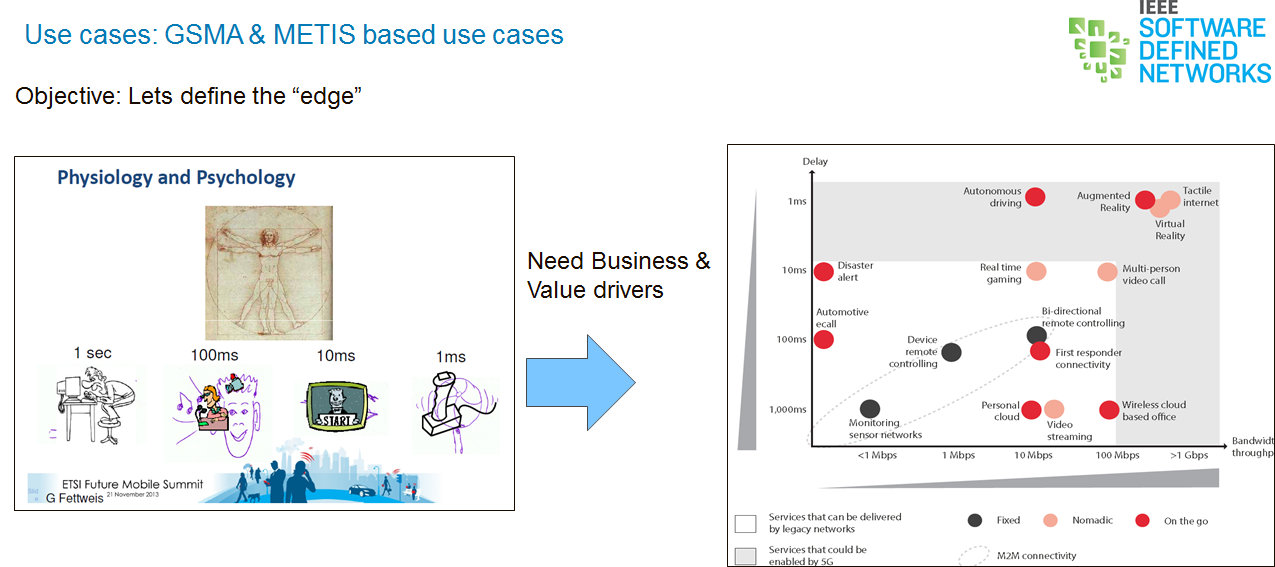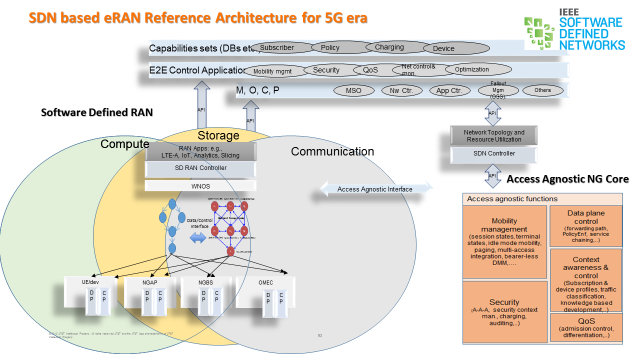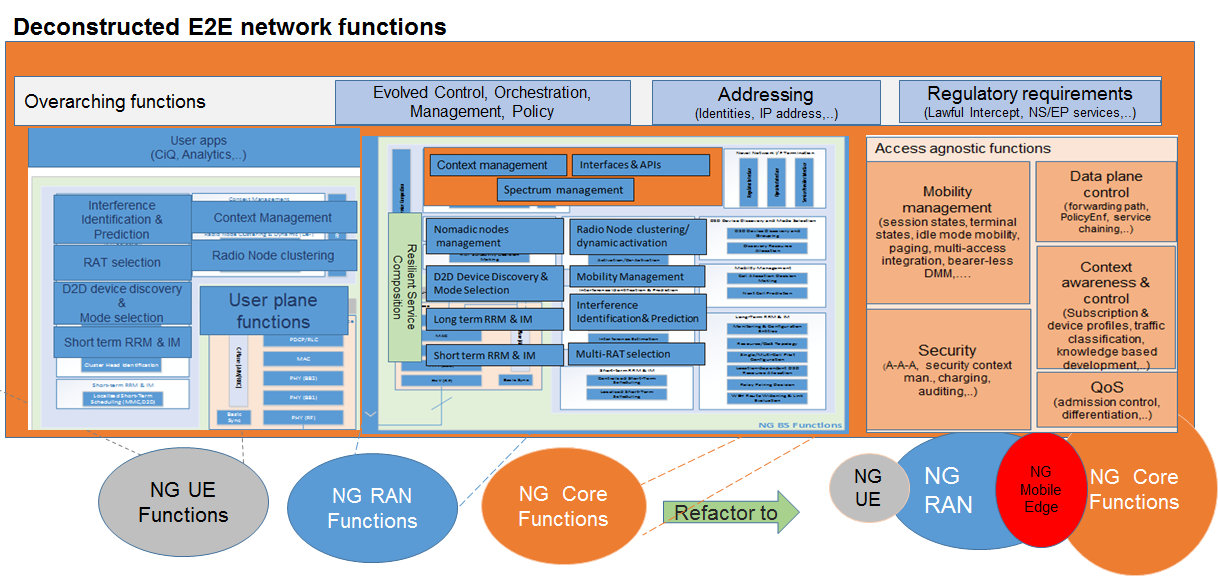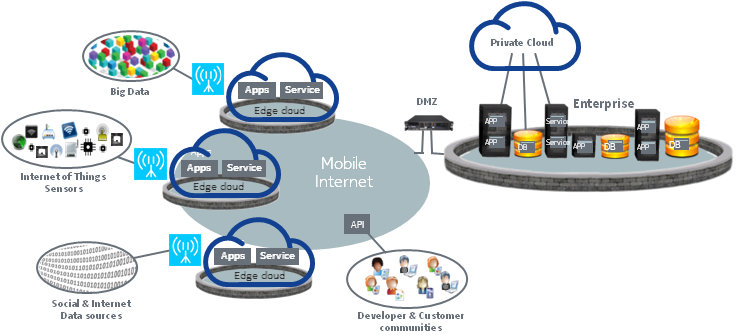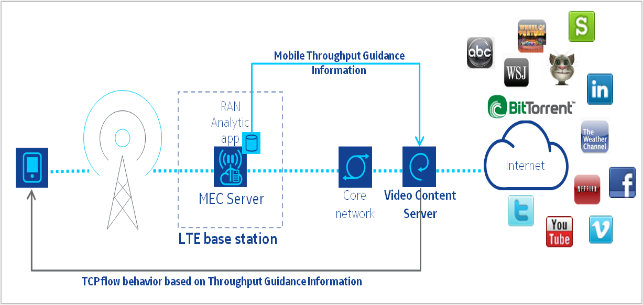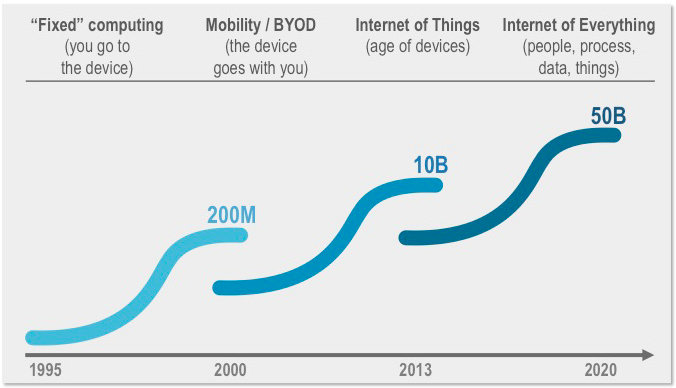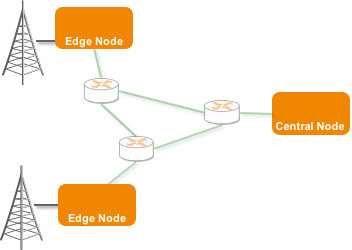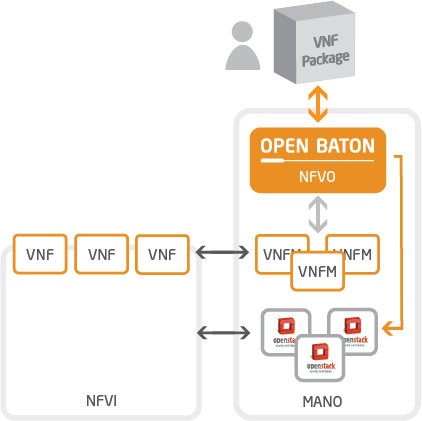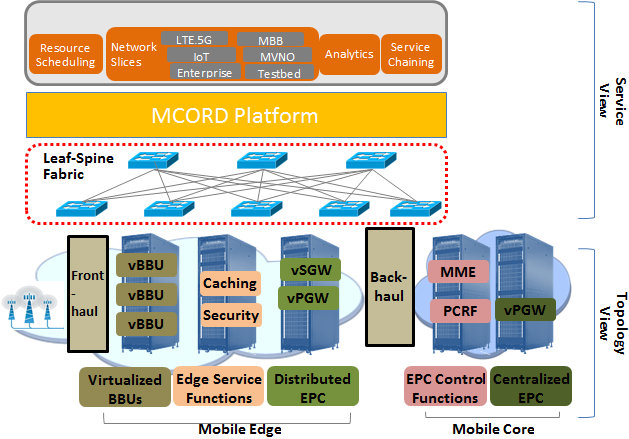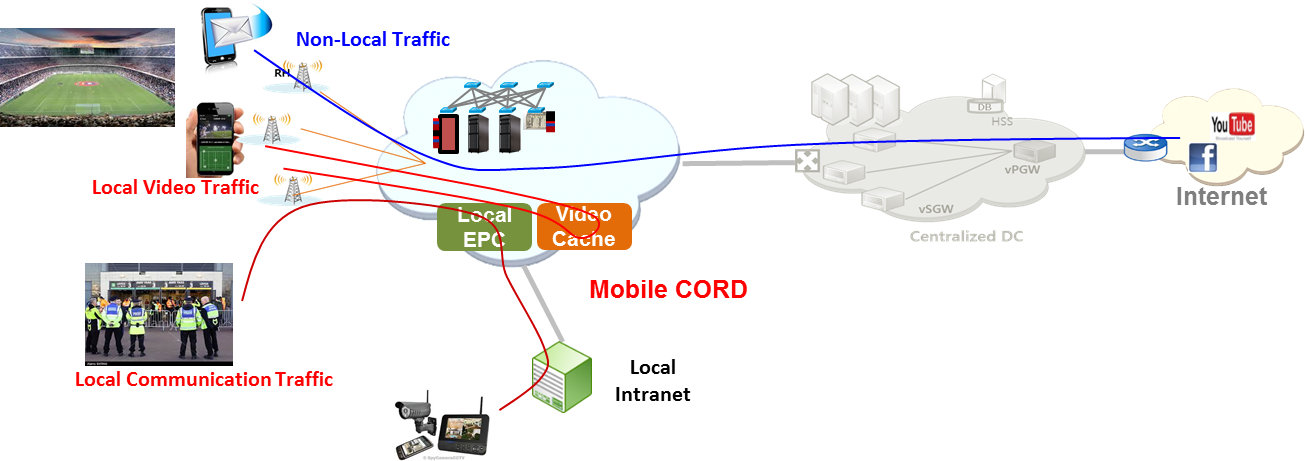Edge Definition and How It Fits with 5G Era Networks
Edge Definition and How It Fits with 5G Era Networks
Cagatay Buyukkoc, PhD, AT&T
1. Edge Definition
From the IEEE workshop that took place in November 20151 on Open Mobile Edge Cloud (OMEC):
An open cloud platform that uses some end-user clients and located at the “mobile edge” to carry out a substantial amount of storage (rather than stored primarily in cloud data centers) and computation (including edge analytics, rather than relying on cloud data centers) in real time, communication (rather than routed over backbone networks), and control, policy and management (rather than controlled primarily by network gateways such as those in the LTE core). (Based on largely Prof Mung Chiang work)
Note that this definition substantially re-architects the whole network. Key components are an application delivery framework on a cloud based system with key functionalities refactored from NG RAN and Core.
The broad set of use cases outlined in various research and standards bodies points to new set of applications that are limited by human Physiology and Psychology2.
What differentiates the 5G era networks is the ability to address varying degrees of requirements (in delay, throughput, types and quantities of devices, etc.) concurrently with a unified framework. This almost dictates a new architectural component that is in close proximity to end users/devices with at most 10km distance to provide the new control and steering applications brought by new use cases.
These requirements are already known very well within the industry and there are these approaches within the 5G community to address those3 as summarized in Figure 2.
Figure 2. Drivers for a evolved RAN in support of 5G era
All Architectural work should be based on a set of Nonfunctional Requirements (NFR) on Technology, Business, and Quality. These are the high level requirements and constraints that determine the evolution direction. Then the architecture4 becomes the functional implementation of these requirements based on these constraints. The strategic NFR might be:
Technology: e.g., use this vs that hypervisor
Business: e.g., create ROI on almost everything, create monetization at the edge, future proof everything etc.
Quality: e.g., provide Resiliency as a key architectural principle, Look at QoE in addition to QoS, do complexity/robustness analysis on services and infrastructure, etc.
2. Call to collaboration on OMEC on a common agenda
Key questions that needs to be answered for the architecture of OMEC is to determine how to merge various activities at the edge on a common platform based on the NFR constraints:
Determine Storage, Compute and Communication needs in a holistic way
Storage: Cloud-based services has originated with Storage and Compute to leverage economies of scale of these common tasks on common (inexpensive) components, and provide high level functions such as resilience through architectural means (SDN/NFV, etc.). However, to address the use cases covered under initiatives such as fog networks, where there are lots of “under-utilized storage” resources in the edge devices, one should create pooling mechanisms and control and management of those. Depending on use case, “ad-hoc” storage networks consisting of enterprise workstations, home servers, local CDN servers, TV set-top boxes, etc. can be pooled to create user slices. Resilience (security, reliability, performance etc. ) can be provided by the OMEC infrastructure using variety of methods (Reed-Solomon coding to provide additional reliability for example.
Compute: Computing at the edge with user devices included are already playing important roles. Edge analytics is a rapidly growing field to process and make use of local traffic in ms latencies. There is also a broad set of new requirements coming from 5G use cases such as Tactile Internet, realtime video traffic optimization etc. Various industry initiatives are creating environments where Application programs such as Analytics are easily pluggable into the OMEC. Furthermore, additional resources obtained from edge networks (e.g., fog networks) that are time-critical and client-centric tasks should be placed in close proximity to the users.
Communication: 5G Era will include a communication infrastructure quite different than what LTE networks currently provide. The cellular networks provide a data plane that extends all the way to the mobile core, it is totally centralized. The control plane is a distributed infrastructure consisting of MMEs, S-gateways, P-gateways, etc. a very distributed system. What we have learned in the study of SDN/NFV frameworks that is being employed in effect is exact opposite: the 5G era will have a quite centralized control plane and a distributed data plane. The desegregated network functions view outlined in Figure 1 gives us a new opportunity to implement this vision. The necessary additional control, configuration and establishment of reachability through the underlying OMEC mechanisms will help provide a new no-cell approach (or create your cell as needed) for all users (e.g.,Wi-Fi , sensory, and ad-hoc networks) currently relying different approaches. Fog networking architecture will be part of the overall communication infrastructure through APIs for new functionalities including network measurement, control, configuration and service definition. Since the future edge devices are much more powerful and diverse, the advanced functionalities can be easily implemented in the edge devices with the benefits of being closer to the network edge. However, some of the networking tasks that require global connectivity and visibility of the network should be still carried out in the OMEC. Some additional helper nodes, such as NG access points will be part of the overall vision as shown in Figure 3.
Figure 3. OMEC vision with distributed C, S, N substrates and a common control plane
3. Concluding Remarks
In Cloud based systems compute, storage and networking components are key to deploying a system that could address the applications we could deploy. There are key questions of how to mix the C, S and N components to deliver a set of applications. This is similar to determination of “eigenvalues”, that is, scaling factors, and “eigenvectors”, that is, fundamental composition of C, S and N. Initially cloud based systems were deployed to have compute and storage components only, however bringing a broad set of networking applications and combining them with compute and storage is the right approach in creating systems that will benefit most of future applications envisioned. Many questions should be addressed quickly through sets of Proof of Concept studies to answer some of these quickly and through global collaborations. There are a great many organizations, groups, research bodies that are addressing the “cloud” based service architectures: IEEE (Open Mobile Edge Cloud), ETSI MEC, IETF, different protocols to address the networking issues, 3GPP on radio interface and control plane/user plane separation, local traffic issues, ITU-T FG on IMT 2020 on fundamental gaps etc. Now is a good time to bring together some of these ideas and put the weight of all industry to specific key areas to make meaningful progress.
1 http://sdn.ieee.org/pre-industrial
2 See various work on Tactile Internet, e.g., http://eandt.theiet.org/magazine/2015/03/tactile-internet-5g.cfm
3 See NGMN, METIS documents etc.
4 See for example Architecture, constraints, and behavior, John C. Doyle and Marie Cseteb
 Cagatay Buyukkoc works for AT&T Architecture and Design organization as a Lead MTS, leading efforts on various SDN/NFV frameworks and RAN evolution target architecture.
Cagatay Buyukkoc works for AT&T Architecture and Design organization as a Lead MTS, leading efforts on various SDN/NFV frameworks and RAN evolution target architecture.
He is also the co-lead of IEEE SDN initiative preindustrial committee. He graduated from METU, with EE BS and MS degrees and a PhD degree from University of California, Berkeley in EECS. Cagatay also obtained an Executive MBA on International Business from Wharton.
He held various technical and management positions in AT&T Bell Labs, Lucent Technologies, ZTE, Cisco and AT&T.
Editor:
 Francesco Benedetto received the Dr. Eng. degree in Electronic Engineering from the University of ROMA TRE, Rome, Italy, in May 2002, and the PhD degree in Telecommunication Engineering from the University of ROMA TRE, Rome, Italy, in April 2007. Since 2008, he has been an Assistant Professor of Telecommunications at the Third University of Rome (2008-2012, Applied Electronics Dept.; 2013-Present, Economics Dept.), where he currently teaches the course of "Elements of Telecommunications" (formerly Signals and Telecommunications) in the Computer Engineering degree and the course of "Software Defined Radio" in the Laurea Magistralis in Information and Communication Technologies.
Francesco Benedetto received the Dr. Eng. degree in Electronic Engineering from the University of ROMA TRE, Rome, Italy, in May 2002, and the PhD degree in Telecommunication Engineering from the University of ROMA TRE, Rome, Italy, in April 2007. Since 2008, he has been an Assistant Professor of Telecommunications at the Third University of Rome (2008-2012, Applied Electronics Dept.; 2013-Present, Economics Dept.), where he currently teaches the course of "Elements of Telecommunications" (formerly Signals and Telecommunications) in the Computer Engineering degree and the course of "Software Defined Radio" in the Laurea Magistralis in Information and Communication Technologies.
He is a Senior Member of the Institution of Electrical and Electronic Engineers (IEEE), and and a member of the following IEEE Societies: IEEE Standard Association, IEEE Young Professionals, IEEE Software Defined Networks, IEEE Communications, IEEE Signal Processing, IEEE Vehicular Technology. Finally, He is also a member of CNIT (Italian Inter-Universities Consortium for Telecommunications). He is the Chair of the IEEE 1900.1 WG on dynamic spectrum access, the Chair of the Int. Workshop on Signal Processing fo Secure Communciations (SP4SC), and the co-Chair of the WP 3.5 on signal processing for ground penetrating radar of the European Cost Action YU1208.
5G Era Networks: The Case for Open Mobile Edge Cloud
5G Era Networks: The Case for Open Mobile Edge Cloud
Cagatay Buyukkoc, PhD, AT&T
1. 5G Era Networks
5G Era Networks defined a decade long transitional period1 and a new end-to-end (E2E) vision that is shaping up in industry and academia. It includes an evolved Radio-Access Network (eRAN), a next generation core, and a management/control plane that extends UE to core and beyond. It is a ubiquitous and responsive mobile-broadband network that will not only carry the (future) Internet traffic but also enable new applications and services. It is not just an air interface people sometimes equate with 5G.
It includes both:
- Evolutionary components of current generations of mobile networks under a unifying umbrella; and
- Revolutionary components that will enable energy and spectral efficiency and new resiliency (i.e., responsive, auto-manageable QoS/QoE, secure, survivable, traffic and disruption tolerant) for services to everyone and everything (applications and machines).
Many new drivers including “Immersive Experience”, “Tactile Internet” enriched by “Context Information”, and “X as a Service” will be adopted and devices such as a significant large number of IOTs will be introduced beyond the current “client-server” models, in which the network infrastructure is reduced to simplistic pipes.
This vision requires a complete revamping of the E2E architecture, services and service. This revamping includes interfaces, management and control frameworks, access and non-access protocols, functions, and advanced algorithms (e.g., AAA), and any type resources (both physical and virtual).
Service Providers (SPs) are currently deploying transformative approaches to provide network functions in appropriate infrastructures (utilizing both centralized and distributed flexible architectural concepts) and thus providing flexible and scalable capabilities according to required use cases and their traffic demands. This flexibility will be achieved using a software defined ecosystem and NFV technologies as well as data path programmability. Target architecture has to be cost and resource efficient as well as auto-managed and flexible. A large adoption of cloud computing, software defined networks and network functions virtualization require new thinking in various key areas to be able to fully utilize and monetize the capabilities presented: e.g., distributed system architecture and elastic and scalable systems.
Most of the research and innovation efforts need to be in place within the next few years to ready large field trials and testing for early deployments in 2020. This can be realized only through global collaboration and investments in key technologies and related fields. Since the required set of capabilities is very broad, establishing ecosystems (both mobile and wireline) is needed, as it will allow global participation through open frameworks.
2. Open Mobile Edge Cloud (OMEC) Vision
As mentioned earlier, various research and standardization bodies have identified that 5G systems should achieve system capacity growth by 1000 fold, energy efficiency gains in the order of 10.
Various efforts are ongoing in the RAN and Core areas to address the architectural principles outlined above. In the RAN space, one of the promising architectures towards that goal was identified as C-RAN (various flavors) as it provides a transition path to the cloud computing based architecture. C-RAN architectures have been in trials in several countries and research labs for the past few years to determine the major benefits, challenges and solutions. The major challenges are fronthaul requirements (e.g., delay, jitter, cost, technology) and the ability of centralized BBUs to provide adequate signal processing in performance targets which basically determine the spectral and energy efficiencies targeted.
Several variants of C-RAN are proposed to address the fronthaul restrictions; one of the promising architectural directions is to decouple user and control planes and progress using the SDN strategy. This also allows a major rethinking of the mobility edge (and subsequently the converged wireline/wireless edge). In this framework, basically a deconstruction of basic functions of RAN and core networks are proposed, as a next step using the deconstructed functions new architectural elements are proposed. One key area of this exercise is the introduction of a new functional node as an intersection point of these functions to be able to create a future proof architecture. This functional node, namely an Open node, will be deployed to provide seamless coverage and execute various control plane functions as well as some of the “core functions” currently placed in various nodes of EPC. More functionality related to Compute and Storage will be added to enable truly cloud capabilities in closer proximities. Since many location-based applications are on the rise (social, analytics, video, etc.) fronthaul load will be considerably higher in the future. A requirement on local storage, compute and networking processing of “edge” services almost forces a new architectural direction.
ETSI/MEC2 and “Fog computing3” are efforts in this direction; trying to address similar issues and identifying that a substantial amount of storage, communication, control, configuration, measurement and management should be placed at the “edge” of a network, in addition to the current cloud paradigms. This idea is based on the premise to certain extensions of cloud computing architectures to the network edge. Figure 1 is a functional decomposition of NG user equipment (UE), RAN and core functions for an E2E architecture of mobile networks in the 5G era. All these are related approaches but much more needs to be done. A proposed framework summary is provided below.
Figure 1. The functional decomposition of NG UE, RAN, core and E2E functions4
3. Concluding Remarks
The deconstruction of functions is a prelude to reconstruction and optimal placement of functionalities, much more than networking, to refactored nodes to address all the considerations outlined above. It is envisioned that NG Mobile edge (subsequently converged edge) will be the center of all 5G era networks with compute and storage functionalities attached, as will be described below briefly. The Open Mobile Edge Cloud (OMEC) concept is a description of this framework.
1 “Networks and Devices for the 5G Era”, Bangerter, Talwar, S., Arefi, R., Stewart, S.IEEE Communications Magazine, February 2014 pgs. 90-96.
2 See, ETSI/MEC overview : http://www.etsi.org/technologies-clusters/technologies/mobile-edge-computing
3 See, http://www.openfogconsortium.org/ for Fog networks related work
4 Decomposition vision created by the author based on METIS work cited earlier
 Cagatay Buyukkoc works for AT&T Architecture and Design organization as a Lead MTS, leading efforts on various SDN/NFV frameworks and RAN evolution target architecture.
Cagatay Buyukkoc works for AT&T Architecture and Design organization as a Lead MTS, leading efforts on various SDN/NFV frameworks and RAN evolution target architecture.
He is also the co-lead of IEEE SDN initiative preindustrial committee. He graduated from METU, with EE BS and MS degrees and a PhD degree from University of California, Berkeley in EECS. Cagatay also obtained an Executive MBA on International Business from Wharton.
He held various technical and management positions in AT&T Bell Labs, Lucent Technologies, ZTE, Cisco and AT&T.
Editor:
 Francesco Benedetto received the Dr. Eng. degree in Electronic Engineering from the University of ROMA TRE, Rome, Italy, in May 2002, and the PhD degree in Telecommunication Engineering from the University of ROMA TRE, Rome, Italy, in April 2007. Since 2008, he has been an Assistant Professor of Telecommunications at the Third University of Rome (2008-2012, Applied Electronics Dept.; 2013-Present, Economics Dept.), where he currently teaches the course of "Elements of Telecommunications" (formerly Signals and Telecommunications) in the Computer Engineering degree and the course of "Software Defined Radio" in the Laurea Magistralis in Information and Communication Technologies.
Francesco Benedetto received the Dr. Eng. degree in Electronic Engineering from the University of ROMA TRE, Rome, Italy, in May 2002, and the PhD degree in Telecommunication Engineering from the University of ROMA TRE, Rome, Italy, in April 2007. Since 2008, he has been an Assistant Professor of Telecommunications at the Third University of Rome (2008-2012, Applied Electronics Dept.; 2013-Present, Economics Dept.), where he currently teaches the course of "Elements of Telecommunications" (formerly Signals and Telecommunications) in the Computer Engineering degree and the course of "Software Defined Radio" in the Laurea Magistralis in Information and Communication Technologies.
He is a Senior Member of the Institution of Electrical and Electronic Engineers (IEEE), and and a member of the following IEEE Societies: IEEE Standard Association, IEEE Young Professionals, IEEE Software Defined Networks, IEEE Communications, IEEE Signal Processing, IEEE Vehicular Technology. Finally, He is also a member of CNIT (Italian Inter-Universities Consortium for Telecommunications). He is the Chair of the IEEE 1900.1 WG on dynamic spectrum access, the Chair of the Int. Workshop on Signal Processing fo Secure Communciations (SP4SC), and the co-Chair of the WP 3.5 on signal processing for ground penetrating radar of the European Cost Action YU1208.
Enhancing Mobile Services with Edge Computing Capabilities
Enhancing Mobile Services with Edge Computing Capabilities
David Lake, Cisco Systems
Abstract — This paper introduces Mobile Edge Computing (MEC), explaining how cloud resources placed close to the consumer can be harnessed to improve user experience across a range of use-cases. MEC provides a practical application of Network Function Virtualization (NFV). The paper concludes by discussing the organisation and operation of the ETSI MEC Industry Standards Group (ISG).
I. Introduction
Mobile users expect better performance and user experience, driven by the prevalence of smart-devices able to offer services such as high-quality video in a highly-mobile environment and by the emergence of the Internet of Things (IoT) comprising a very large number of small, low-data rate devices.
Whilst well understood, current mobile architectures are fixed in nature, delivering current applications well. However, today’s 3rd Generation Partnership Project (3GPP) solutions are based around a static, anchor-based topology, which, whilst enabling a degree of mobility within the network, does so with sub-optimal latency and paths through the mobile packet-core network.
MEC enables resources to be placed closer to the end-user, taking into account the relative locations of producers and consumers. By referencing the underlying radio transport, all resources, Radio Access Network (RAN), IT services and packet core, are exposed to applications, allowing the full infrastructure state to be considered.
II. Mobile Edge Computing – a Local Cloud
The basic premise of MEC is to place generic compute and storage close to the network edge in a mobile network environment. This extends the cloud, typically a centralised, single resource, to the local environment. Whilst the MEC environment would be embedded in and managed from the operator environment, it is intended that the compute/storage resources will be exposed via a set of APIs such that application operators and developers can utilise their capabilities. Figure 1 shows the position of the MEC engine within a mobile architecture.
Figure 1 Mobile Edge Services Architecture [1]
Compared with the traditional 3GPP architecture of tunnels from the edge to centre of the network where data service breaks-out to either the Internet or to corporate data services (for example, by the use of GTP tunnels centred on the P-GW), MEC envisages data break-out at the edge of the network using current Local IP Access (LIPA)/Selected IP Traffic Offload (SIPTO) techniques, which is then handled by applications residing on the MEC engine. Compared to centralised SDN solutions, MEC is a distributed architecture where content and applications will be positioned by application providers.
This proximity to the user enables higher bandwidth and lower latency than would be possible in the tunnelled environment, but offers other benefits, such as the ability to run locally-targeted services on edge devices which are closely-coupled to the radio network. Exposing Radio Network Information Services (RNIS) [1] provides a tighter coupling between the quality metrics available from the radio node (e.g. LTE Base Station) than is currently possible as this data is currently buried deep in the core network.
The MEC community has worked to detail several use-cases that are not predicated on bandwidth and/or latency improvements. Next, we overview some of these identified use-cases – see [2] for more details.
Consumption of high-bandwidth video on mobile devices has grown rapidly in recent years, typically delivered from caching services. Unlike wireline networks where Content Delivery Networks (CDNs) exist as overlays intercepting content requests and enabling delivery from topologically close caches, in a cellular environment, content is served from the centre of the network. This architecture enables easy mobility of the user across multiple radio attachment points, but it does not allow local selection of content cache resulting in sub-optimal IP data flows. In addition, the central content cache has no knowledge of the quality or capability of the radio link, simply seeing an IP request for content.
MEC addresses these issues in two ways (Figure 2):
Figure 2- Video Optimisation with MEC [2]
- Through interaction with the central content provider, content may be positioned closer to the consumer, eliminating the slow start and buffering of content often experienced in mobile environments. Where there are a large number of potential consumers within the domain of the MEC server, e.g. at an aggregation point, the MEC engine acts as multicast replication device.
- Where it may not be beneficial to pre-position content, the CDN service now has visibility of the RNIS and content may be locally adapted (e.g. re-rated, offered at a lower resolution).
Figure 3 - Augmented Reality [2]
Other services to enhance consumer experience such as augmented reality, shown in Figure 3, customer information, safety-related services or analytic information to enterprises (e.g. retail customer foot-fall) can also be considered, where object representation is used between core and edge to reduce traffic flow.
Given the projected development of the Internet of Things (Figure 4), MEC may also be used for IoT applications. IoT solutions typically involve a large number of devices, but small amounts of data and a range of tolerances to latency.
Figure 4- IoT Adoption Rate [3]
For example, in an industrial environment where instrumentation is used for a control or manufacturing process and low-latency is key, MEC will provide an engine whereby local application decisions can be made at optimum speed while preventing leakage of potentially sensitive operational data to the public network.
For other, non-latency critical applications, for example where data changes slowly in relation to network transport time, the ability to host local applications will provide resilience in the event of a network failure.
Closely aligned with the MEC service edge, Fog computing is a method to realise the predicted scale of IoT by moving portions of applications to edge devices in a co-ordinated and centrally orchestrated fashion. Fog can therefore be seen as an example application that could make use of the availability of MEC engines around the mobile network. Fog management tools would be able to understand capabilities around the environment and distribute intelligence as needed.
III. ETSI MEC ISG
The ETSI MEC ISG is a group of mobile operators, application developers, content providers, software vendors, system integrators and manufacturers working on development and standardisation of the Mobile Edge Computing concept.
The ISG has been formed to produce an interoperable and deployable Group Specification across a number of release cycles. The ISG liaises with groups both within ETSI (e.g. the NFV ISG) and other relevant bodies such as IEEE and 3GPP. Early proof-of-concepts and prototypes are being built and demonstrated, together with development of an interoperability framework including test support, tools and SDKs with the aim of promoting a multi-vendor, standards-based landscape. The ETSI MEC White Paper [1] details the organisation and operation of the ISG.
IV. Outlook
As a complementary technology to SDN and NFV, MEC will provide an enhanced experience for consumers by delivering optimised bandwidth and latency for varying use-cases and open platforms for the deployment of new applications.
MEC is designed as a key component of the 5G packet-core network. It will bring the ability to deliver a range of user-outcomes such as different throughputs and latencies across a wide range of use-cases.
The MEC ISG is currently working towards publication of the MEC Group Specification during 2016. The group also works to increase the interest in and promote the adoption of MEC through presentations at industry events and through the support and promotion of Proof of Concepts (PoCs).
V. References
[1] M. Patel, Y. Hu, P. Hédé, J. Joubert, C. Thornton, B. Naughton, J. Ramos, C. Chan, Valerie Young, Soo Jin Tan, Daniel Lynch, N. Sprecher, T. Musiol, C. Manzanares, U. Rauschenbach, S. Abeta, L. Chen, K. Shimizu, A. Neal, P. Cosimini, A. Pollard and G. Klas, Mobile-Edge Computing – Introductory Technical White Paper, 1st ed. Sophia Antipolis: ETSI, 2014.
[2] R. Schuster, Boosting User Experience by Innovating at the Mobile Network Edge, 1st ed. Sophia Antipolis: ETSI, 2015.
[3] J. Bradley, J. Barbier and D. Handler, Embracing the Internet of Everything to Capture Your Share of $14.4 Trillion, 1st ed. San Jose: Cisco Systems Inc., 2013.
 David Lake is an Architect in the Mobility CTO group at Cisco, having joined Cisco in the UK in 1998. David has over 25 years’ experience designing and building networks to support a multitude of services, from transactional data to voice and video in both Enterprise and Service Provider environments, and where the two worlds cross. He has an interest in IoT wireless and core networks and represents Cisco at the Wireless IoT Forum and the ETSI MEC ISG. He holds a BSc in Electronics and an MSc in Telecommunications.
David Lake is an Architect in the Mobility CTO group at Cisco, having joined Cisco in the UK in 1998. David has over 25 years’ experience designing and building networks to support a multitude of services, from transactional data to voice and video in both Enterprise and Service Provider environments, and where the two worlds cross. He has an interest in IoT wireless and core networks and represents Cisco at the Wireless IoT Forum and the ETSI MEC ISG. He holds a BSc in Electronics and an MSc in Telecommunications.
Editor:
 Kostas Pentikousis is the Head of IT Infrastructure at the European Center for Information and Communication Technologies (EICT GmbH) in Berlin, Germany. Previously, he was Senior Research Engineer and standards contributor and delegate at Huawei Technologies. He was earlier Senior Research Scientist at VTT Technical Research Centre of Finland and ERCIM Fellow. He received his Ph.D. in computer science from Stony Brook University.
Kostas Pentikousis is the Head of IT Infrastructure at the European Center for Information and Communication Technologies (EICT GmbH) in Berlin, Germany. Previously, he was Senior Research Engineer and standards contributor and delegate at Huawei Technologies. He was earlier Senior Research Scientist at VTT Technical Research Centre of Finland and ERCIM Fellow. He received his Ph.D. in computer science from Stony Brook University.
His research interests include network architecture, system and protocol design and implementation. Visit http://linkedin.com/in/kostas for more biographical details and to get in touch.
MEC Enablement by Means of an Open Source ETSI MANO Orchestrator
MEC Enablement by Means of an Open Source ETSI MANO Orchestrator
Giuseppe Antonio Carella and Prof. Dr. Thomas Magedanz, Technische Universität Berlin, Fraunhofer FOKUS
With the still growing number of mobile Internet users and the, albeit being not as fast, growing number of mobile Internet devices per person, the Next Generation Network (NGN) infrastructures will be increasingly challenged in the upcoming years. For reducing the impacts of such growing traffic, Network Function Virtualization (NFV) and 5G trends are towards deploying software-based Network Functions on a heterogeneous infrastructure composed by a very large number of datacenters, able to dynamically cope with situation of peak loads.
As envisioned by the NGNM white paper [1], 5G will have to deal with many different requirements coming from different domains, therefore the dynamicity, and in particular the flexibility, are key enablers for rapid innovation. Furthermore, this rapid deployment of datacenters is paving the way towards a different type of environment in which the computational resources are deployed up to the edge of the network. ETSI Mobile Edge Computing (MEC) [2] envisions the idea of offering cloud computing capabilities to service providers and application developers at the edge.
Figure 1. Mobile Edge Computing deployment architecture
With MEC in place, it will be possible to deploy services and applications closer to the users/devices, allowing the reduction of data volumes exchange and latency, with enhancements to the Quality of Service perceived by the end users.
However, the current standardization bodies don’t have concrete solutions yet, and due to the large number of working items, it is quite complex to align and agree upon a single architecture. The ETSI NFV [2] group proposes a multi-site NFV Infrastructure (NFVI) where different Point of Presences provide cloud capabilities for hosting Virtual Network Functions (VNFs). While, the ETSI MEC [3] group proposes an architecture for the edge nodes, which are integrated as NFVI PoPs in the ETSI NFV architecture. However, at this stage, it is pretty complex to foresee a clear definition of the interfaces and protocols which could make this possible.
The early prototyping of new concepts and architectures, is probably the key for building successful standards, and, at the moment, it represents the only certainty in such fragmented environment. Open Source (OS) software and toolkits have proven in the past to be of great value in the next generation networks and future internet context and thus are considered key for understanding and mastering the challenges of the complex emerging 5G environment.
In particular, Fraunhofer FOKUS and TU Berlin have been working since many years integrating OS solutions together with industry and academia, in their so called “testbeds to go”. Their OS toolkits, like the Sip Express Router (SER) and the Open IP Multimedia Subystem (IMS) Core, have been catalysts for understanding the technical challenges and developing corresponding standards in the VoIP and NGN domains and have been the foundation for creating technology innovation labs around the globe. Some good examples of such labs are the IMS [4] and the FUSECO Playground [5].
By exploiting their long-term expertise in analyzing Next Generation Network (NGN) Infrastructures and implementing versatile tools, they launched a new open source platform, Open Baton [6][7], providing the means for building a complete NFV environment based on the ETSI MANO [8] specification.
Figure 2. Open Baton Architecture
Open Baton provides a NFVO for managing Network Services, a generic VNFM supporting the execution of lifecycle events provided in the VNF Descriptors, and a lightweight Element Management System (EMS) instantiated on demand for executing lifecycle events on the deployed resources. Open Baton allows the instantiation of any kind of Network Service. It follows the ETSI MANO v1.1.1 [8] specification and provides a catalogue of VNFs which can be composed together in a Network Service and deployed on a multi site NFVI. One of the key features of the NFVO is the capability of controlling multiple types of Virtual Infrastructure Managers dislocated on different locations providing the means for initial prototypes of on demand deployment of VNFs on the edge of the network. It interacts with OpenStack via a driver mechanism, which can be easily extended for supporting other lightweight MEC technologies, like Docker [9] or Kubernetes [10], which may be required on those PoPs for reducing operational costs.
The objective is to share the gained experiences enabling researchers around the globe to build their own 5G/SDN/NFV/MEC testbeds, as well as to create the needed knowhow for emerging 5G standards with initial Proof of Concepts (PoC) in this domain. However, Open Baton represents just one of the key components of those NGN Architectures, and there is a need of building a full ecosystem which can demonstrate the feasibility of key features for future networks. Typically Fraunhofer FOKUS and TU Berlin are developing “OpenXXX” toolkits which can be combined together for building a comprehensive testing environment. These assets will be contributed to the newly created IEEE SDN Work Group “Open Source SDN/NFV/MEC Toolkits & Testbeds Work Group”, in which one of the aim is to setup a repository of useful open source toolkits, and an international community of dedicated experts around them, to share their experiences on useful combinations of these toolkits for realising different PoCs. Another example of state of the art 5G testbed is the FOKUS 5G Playground [11] combining both Open Source toolkits and closed source toolkits / pre-products developed by Fraunhofer FOKUS and TU Berlin as part of their strong collaboration, which is also part of the 5G Berlin initiative [12] where Fraunhofer FOKUS and Fraunhofer HHI are collaborating together for building a comprehensive 5G ecosystem, as a single stop-shop for Radio and Core R&D.
References
[1] NGNM White Paper, online https://www.ngmn.org/uploads/media/NGMN_5G_White_Paper_V1_0.pdf
[2] ETSI NFV Architectural Framework v1.2.1 (2014-12), online http://www.etsi.org/deliver/etsi_gs/NFV/001_099/002/01.02.01_60/gs_NFV002v010201p.pdf
[3] ETSI Mobile Edge Computing, online http://www.etsi.org/technologies-clusters/technologies/mobile-edge-computing
[4] Magedanz, T.; Witaszek, D.; Knuettel, K., "The IMS playground @ FOKUS-an open testbed for generation network multimedia services," in Testbeds and Research Infrastructures for the Development of Networks and Communities, 2005. Tridentcom 2005. First International Conference on , vol., no., pp.2-11, 23-25 Feb. 2005
[5] FUSECO Playground , online https://www.fokus.fraunhofer.de/go/en/fokus_testbeds/fuseco_playground
[6] Open Baton: an open source Network Function Virtualisation Orchestrator (NFVO)
fully compliant with the ETSI NFV MANO specification, online http://openbaton.org
[7] Open Baton video, online https://www.youtube.com/watch?v=e9VbeRohjJ8&feature=youtu.be
[8] ETSI GS NFV-MAN 001 (MANO), online https://www.etsi.org/deliver/etsi_gs/NFV-MAN/001_099/001/01.01.01_60/gs_NFV-MAN001v010101p.pdf
[9] Docker, online docker.com
[10] Kubernetes, online kubernetes.io
[11] 5G Playground, online https://www.fokus.fraunhofer.de/go/en/fokus_testbeds/5g_playground
[12] 5G Berlin initiative, online www.5g-berlin.org
 Thomas Magedanz is a professor in the electrical engineering and computer sciences faculty at the Technical University of Berlin, Germany, leading the chair for next
generation networks (Architektur der Vermittlungsknoten / AV) and director of the 'NGNI' division at the Fraunhofer Institute FOKUS, which provides toolkits and open experimental platforms for fixed and mobile Next Generation Networks.
Thomas Magedanz is a professor in the electrical engineering and computer sciences faculty at the Technical University of Berlin, Germany, leading the chair for next
generation networks (Architektur der Vermittlungsknoten / AV) and director of the 'NGNI' division at the Fraunhofer Institute FOKUS, which provides toolkits and open experimental platforms for fixed and mobile Next Generation Networks.
More details: http://www.av.tu-berlin.de/menue/team/prof_dr_thomas_magedanz/
 Giuseppe Antonio Carella is a Senior Researcher at the Fraunhofer FOKUS and at the Technische Universität Berlin (TUB). He received his M.Sc. in Engineering of Computer Science from the Alma Mater Studiorum University of Bologna in 2011. He is currently leading the team developing the Open Baton toolkit, an open source platform providing the means for building a comprehensive NFV environment.
Giuseppe Antonio Carella is a Senior Researcher at the Fraunhofer FOKUS and at the Technische Universität Berlin (TUB). He received his M.Sc. in Engineering of Computer Science from the Alma Mater Studiorum University of Bologna in 2011. He is currently leading the team developing the Open Baton toolkit, an open source platform providing the means for building a comprehensive NFV environment.
More details: http://www.av.tu-berlin.de/carella
Editor:
 Marie-Paule Odini is a seasoned HPE executive, bring over 25 years of telecom experience. She has deep expertise in both the networking and IT environments, NFV, SDN and M2M/IoT.
Marie-Paule Odini is a seasoned HPE executive, bring over 25 years of telecom experience. She has deep expertise in both the networking and IT environments, NFV, SDN and M2M/IoT.
Marie-Paule is Distinguished Technologist for CMS, Communication and Media Solution organization, focused on customer innovation and emerging trends in the communication industry. She leads the technology discussions for NFV (Network Function Virtualization), M2M, Analytics, Cloud. She seats on ETSI, ATIS, IEEE and other standard bodies. She is Vice-chairman of ETSI NFV ISG, seats on the Technical Steering Committee, is a Vice Chair of TST working group (testing, interoperability and Opensource), rapporteur of SDN work item, and Vice Chair in IEEE SDN. She participates in European Commission SDN-NFV task force, and is also active on M2M & IoT, within ETSI and OneM2M, rapporteur of TG28 low throughput network work items, working with new players such as Sigfox or LORA technologies. She holds a few patents and is also a frequent industry speaker and editor in professional magazines and blogs, incl HPE Telecom IQ.
Marie-Paule prior responsibilities include managing HP’s worldwide VoIP program, HP’s wireless LAN program, and HP’s Service Delivery program. Since joining HP in 1987, she has held positions in technical consulting, sales development and marketing in Europe and in the Americas. Those roles have focused on strategic and operational responsibility for Networking, IT and operations in the telecom domain.
Marie-Paule holds a master’s degree in Electrical Engineering from Utah State University and business education from INSEAD, Paris. Prior to joining HP, Marie-Paule spent five years with France-Telecom/Orange research and development labs, defining architecture and value-added services launch for corporate customers. She enjoys skiing and outdoors in general.
Rethinking the Mobile Edge Network with CORD (Mobile-CORD)
Rethinking the Mobile Edge Network with CORD (Mobile-CORD)
Mingeun Yoon, SK telecom; Tom Tofigh, AT&T; and Guru Parulkar, Open Networking Lab
Abstract: To open-up the wireless interfaces and achieve cloud benefits and agility based on SDN/NFV, Mobile CORD (M-CORD) is presented. The mobile Edge solutions enabled by M-CORD demonstrate practical and scalable models for services that require higher throughput and lower delay while minimizing the resource impacts on core network functions.
1. Introduction
Mobile networks today are facing the challenges of explosive mobile data growth mostly driven by smart devices and over-the-top (OTT) services like video streaming, social networking, and gaming. These challenges will be even more accelerated by emerging IoT use cases e.g. smart cities, and bandwidth-hungry applications such as HD video, Augmented Reality, and Virtual Desktops.
On the other hand, such demands can be an opportunity for mobile operators if infrastructure is ready for the proliferation of devices, traffic, and new business models. However, innovating with new mobile network services in an agile way is not only complicated today, but also time-consuming due to closed interfaces and embedded/monolithic control functions.
This work intends to enable service providers to build mobile edge solutions utilizing white-box hardware, open source SDN platforms, and a set of unified network control and management applications that can promote innovation and rapid deployment of new services. The M-CORD approach will leverage open interfaces to address cloud, NFV, and SDN basic objectives, while positioning service providers, partners and vendors for proofs-of-concept (PoCs) with 5G-based services in mind.
ON.Lab and partners including AT&T, SK Telecom, Verizon, and collaborators (Cavium, NEC/NetCracker, Radisys, Cobham, Airhop) will extend the ON.Lab Central Office Re-architected as a Datacenter (CORD) project to exercise RAN and EPC component disaggregation and virtualization, providing customized services at the mobile edge on an open platform. This is intended to support PoCs for service opportunities such as: Video on Demand, Personalization of Services for Local Communities, Localized Security-as-a-Service, and edge services such M-Health, and IoT-as-a-Service.
2. Central Office Re-architected as Data Center (CORD)
ON.Lab’s CORD [1] project seeks to bring the economies of a datacenter and the agility of the cloud to central office (CO) functions of telco service providers.
CORD is an effort to re-invent the CO by replacing purpose-built devices with more agile software-based ones through leveraging the following three significant practices: (1) SDN, which separates the network’s control and data planes, allowing for more programmable and simplified control/data planes focused on innovation, and support for white-box hardware; (2) NFV, which enables replacement of hardware-based network appliances with software-based virtual machines, reducing capital and operational costs, and increasing agility; (3) Cloud, which enables innovative and scalable services with rapid time to market.
3. Mobile CORD
Mobile operators want to make their networks cost efficient and performant, flexible via programmability and agile for new services that can cope with the challenges of user demands, as well as to create new revenue.
However the current cloud service model is poorly suited for delay-sensitive applications. This concern becomes clear in use cases such as video applications for smart cities and industrial M2M applications. For these use cases, focusing on the network edge has attractive and distinguishing features such as proximity to end-users, location-awareness, radio resource information awareness, and dense geographical deployment. These advantages can enable low-latency, high-throughput and customized services that bring better user experience while the reducing load on core networks.
To demonstrate the opportunity of service deployment at the mobile edge, ON.Lab, partners and collaborators are developing the M-CORD platform. M-CORD will not only utilize virtualized RAN and EPC functions, but also disaggregate control functions from the data plane. M-CORD will also demonstrate how micro-cells can be mapped to multiple control planes with customized resource optimization, increasing capacity and reducing delay for critical localized applications such as services for hospitals, schools, and smart cities.
M-CORD’s mobile-edge design will include: (1) a single SDN control plane built using ONOS to control virtualized RAN and EPC components; (2) SDN/NFV-based resources that can be built and sliced to provide mobile services with the performance needed. Together these will be used to demonstrate several network services at the mobile edge such as Self-Organizing Network (SON) applications and local Caching.
The following diagram shows mobile edge services such as video cache deployed together with local Evolved Packet Core (EPC) co-located with virtual Baseband-Units (vBBU), illustrating possible opportunities of opening up the mobility interfaces with further disaggregation in the EPC and BBU.
Like other CORD PoCs, the M-CORD platform architecture adopts the Openflow based SDN control method of ONOS and building blocks based upon commodity hardware and open software solutions. Cost efficiency and agility are expected to be achieved by this framework. This architecture enables customized service chaining and policies, and supports real time analytics observability at the network edge. Through it, service providers can offer customers sliced virtualization resources and the ability to manage their own mobility control strategies.
M-CORD will replace standard mobile network components e.g. BBU, MME, SGW, PGW with white-box servers, switches, and openflow-enabled interfaces to enable services such as FWaaS, DNSaaS, Caching-as-a-Service, etc. This is intended to demonstrate a more agile and scalable service environment, in which mobile network functions can run as services which are deployed dynamically and on-demand. By this, overutilization and underutilization of network resources is avoided.
With network functions deployed at the mobile edge, edge-caching can improve user QoE (Quality of Experience) via enhanced with low latency and high bandwidth, while benefitting the service provider via reduced backhaul traffic and central network system load.
4. Conclusion
M-CORD will demonstrate the value of edge-based services for boosting resource optimization, capacity, and QoE for latency-sensitive applications. The SDN/NFV-based deployment and programmability of M-CORD will demonstrate a much smarter and cost-effective network platform for service providers. The M-CORD architecture is intended to enable operators and their partners to tap into new, localized high-margin revenue streams offering services such as gaming, streaming, IoT, Public Safety, Big Data Analytics, Mobile Health, Education, Smart Cities, Smart Vehicles, and much more, with improved QoE and agility. M-CORD’s commoditization of open source components and interfaces will open-up wireless interfaces while promoting a level playing field with OTT services. M-CORD will demonstrate an innovative path via which key cross-industry stakeholders – Service providers, MVNOs, equipment providers, software vendors, and industry bodies – can take 5G from the lab into the mainstream.
5. References
[1] Larry Peterson, “CORD: Central Office Re-architected as a Datacenter,” Open Networking Lab white paper 2015.
[2] ETSI White Paper No. 11, Mobile Edge Computing, a key technology towards 5G, Sept 2015
[3] M. Hanif, Light Reading: “Network and communications Industry”, 2015 Mobile Edge Computing
 Mingeun Yoon has more than 13 years of experience in the area of mobile core network since he joined SK Telecom in 2002. He is now a member of 5G Technology team of SK telecom R&D center, where he is working on designing the next generation mobile network architecture mostly by leveraging SDN and NFV.
Mingeun Yoon has more than 13 years of experience in the area of mobile core network since he joined SK Telecom in 2002. He is now a member of 5G Technology team of SK telecom R&D center, where he is working on designing the next generation mobile network architecture mostly by leveraging SDN and NFV.
 Tom Tofigh is currently a Principal Member of Technical Staff in the AT&T’s Domain 2.0 architecture and planning Labs at AT&T. He has been working with On.lab on AT&T specific use cases for CORD projects. He holds over 30 patents awarded and many more pending.
Tom Tofigh is currently a Principal Member of Technical Staff in the AT&T’s Domain 2.0 architecture and planning Labs at AT&T. He has been working with On.lab on AT&T specific use cases for CORD projects. He holds over 30 patents awarded and many more pending.
 Guru Parulkar has been involved in the field of networking for over 25 years, including academic work at Washington University in St. Louis prior to Stanford, and private sector experience at several startups, Cisco, and the National Science Foundation. He is currently the Executive Director of Open Networking Research Center (ONRC), Executive Director of Open Networking Laboratory (ON.Lab) and Consulting Professor of EE at Stanford University.
Guru Parulkar has been involved in the field of networking for over 25 years, including academic work at Washington University in St. Louis prior to Stanford, and private sector experience at several startups, Cisco, and the National Science Foundation. He is currently the Executive Director of Open Networking Research Center (ONRC), Executive Director of Open Networking Laboratory (ON.Lab) and Consulting Professor of EE at Stanford University.
Editor:
 Eliezer Dekel is a Chief Architect for Huawei Technologies Corporate Reliability Department. He is researching RAS for SDN and NFV. He retired from IBM Research - Haifa, as a Senior Technical Staff Member and Chief Architect for Distributed Systems. In his this role he focused on developing infrastructure technologies for very large scale distributed systems.
Eliezer Dekel is a Chief Architect for Huawei Technologies Corporate Reliability Department. He is researching RAS for SDN and NFV. He retired from IBM Research - Haifa, as a Senior Technical Staff Member and Chief Architect for Distributed Systems. In his this role he focused on developing infrastructure technologies for very large scale distributed systems.
Eliezer Dekel is the editor in chief of EAI Endorsed Transaction on Cloud Systems. He is also an Associate Editor for ACM Computing Surveys and a member of the editorial board for IEEE SDN Newsletter. Eliezer served on numerous conference program committees and organized, or served as chair in some of them. He has been involved in research in the areas of distributed and fault-tolerant computing, service-oriented technology, and software engineering. He was recently working on technologies for providing Quality of Service, with a focus on dependability, in very large scale multi-tier environments. For this area he initiated together with colleagues the very successful International Workshop on Large Scale Distributed Systems and Middleware (LADIS). This workshop, sponsored by ACM. It was one of the first workshops to focus on the foundations of "cloud computing." He was an organizer of CloudSlam'09 the first cloud computing virtual conference. Eliezer was also involved in several EU FP7 ICT funded projects.
Eliezer has a Ph.D. and M.Sc. in computer science from the University of Minnesota, and a B.Sc. in mathematics from Ben Gurion University, Israel. Prior to joining IBM Research - Haifa, Eliezer served on the faculty of the University of Texas at Dallas computer science department for more than ten years.




